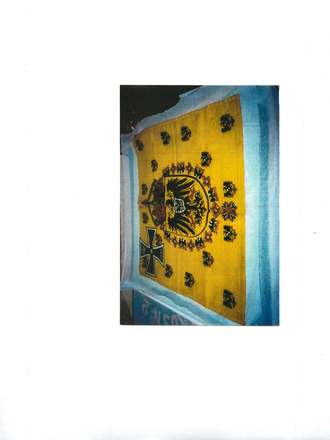Germany Standard of the Empress Auguste Viktoria.
This Imperial German Standard of Empress Augusta Viktoria was formerly part of the collection of the M.H. de Young Museum. Founded in 1895 in San Francisco's Golden Gate Park, the de Young Museum was San Francisco's first museum. It was an immediate success as soon as it opened and has been an integral part of the cultural fabric of the city and a cherished destination for millions of residents and visitors to the region for over 100 years.
Michael Henry de Young ,1849 -1925, was an American journalist and businessman who owned and published the San Francisco Chronicle. He used his wealth to further his eclectic tastes and accumulated a collection of immense variety, and such diverse objects such as sculptures, paintings, flags, polished tree slabs, paintings, objet d'art, jewelry, a door reputedly from Newgate Prison, birds' eggs, handcuffs and thumbscrews, and a collection of knives and forks.
As San Francisco's premier repository the de Young Museum came to house a number of flags. This flag was acquired by the De Young museum directly from Mr. de Young himself in 1909. He was given the flag by Augusta Viktoria, Empress of Germany.
This flag is a typical example of the elegant and complicated standards used by German rulers until the early 20th century. The design is a variation of the imperial standard used by Augusta Viktoria's husband, Kaiser Wilhelm II. The principal differences are the location of the Iron Cross in the upper hoist corner (rather than across the center of the field), the substitution of the empress' crown for the imperial crown and the omission of miniature imperial crowns on the background. The fact that the flag is made of wool rather than silk suggests that it was used on a ship, perhaps the imperial yacht.
The different design elements refer to the history of the family and the titles they claimed. The background is the imperial color, gold, and bears imperial eagles spaced evenly to form a pattern with the shield of the Hohenzollern family dominating the central foreground. The Iron Cross bears the date of the founding of the Second Reich (1870). Also in the center rests the Prussian Order of Merit and the crown of the empress decorate the arms of the Holy Roman Empire. The gold shield with a black eagle dates back to the 13th century.
The shield on the breast of the imperial eagle is white. It bears the black eagle of Prussia, of which Augusta Viktoria was queen. The breast of the Prussian eagle bears the white and black quartered shield of the Hohenzollern family, emperors of Germany from 1871 to 1919. The Prussian arms were originally a variation of the Holy Roman Empire arms. Ultimately, the eagle symbol still used by Germany today is based on the standards carried by the Roman Empire in antiquity with artistic variations in the shield.
Empress Augusta Viktoria (October 22, 1858 - April 11, 1921), was the last German Empress and Queen of Prussia.
ZFC Significant Flag
Item is Framed
Provenance:
• Made in Germany for Empress Augusta Viktoria
• Gifted to M.H. de Young.
• Gifted to de Young Museum, 1909.
• Sold via Butterfield & Butterfield Auctions, SF, CA, to the Zaricor Flag Collection, 1997
Sources:
History of the de Young Museum, de Young, Fine Arts Museums of San Francisco, 15 November 2011: http://deyoung.famsf.org/about/history-de-young-museum
Augusta Victoria of Schleswig-Holstein, Wikipedia, 17 November 2011, from: http://en.wikipedia.org/wiki/Augusta_Victoria_of_Schleswig-Holstein
Kaiserinstandarte, Empress' Standard 1871-1918 (Germany), Flags of the World, 17 November 2011, from: http://www.crwflags.com/fotw/flags/de1871kn.html
Image Credits:
Zaricor Flag Collection














